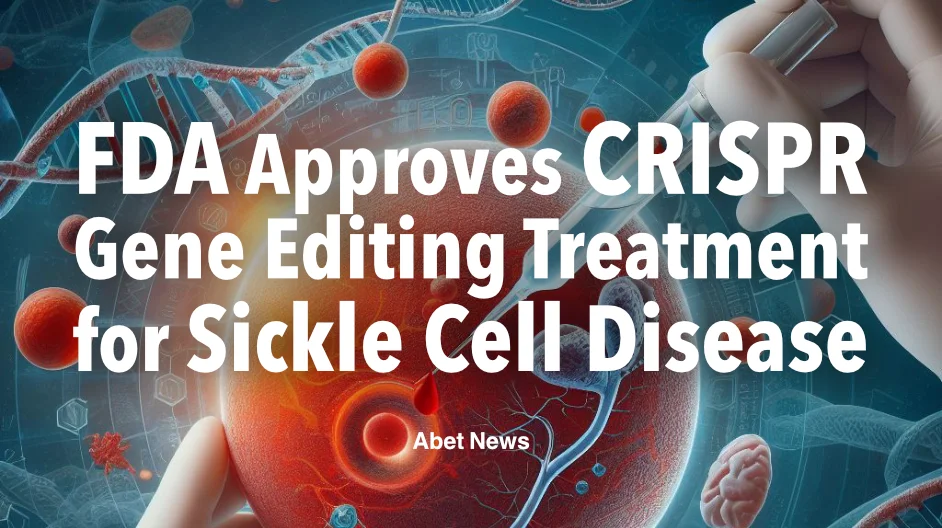FDA Approves CRISPR Gene Editing Treatment for Sickle Cell Disease

Sickle cell disease is a painful and deadly disorder that affects about 100,000 people in the US, mostly African Americans. For decades, there was no cure for this genetic condition, until now. The FDA has recently approved the first CRISPR gene editing treatment that could potentially cure sickle cell disease by correcting the mutation that causes it. In this article, I will explain how this treatment works, what are its benefits and risks, and what are the implications for the future of medicine.
What is sickle cell disease and how does CRISPR gene editing work?
Sickle cell disease is a disorder that affects the shape and function of red blood cells, which carry oxygen throughout the body. People with sickle cell disease have a mutation in a gene called HBB, which makes a protein called hemoglobin. Hemoglobin is responsible for binding oxygen to red blood cells. The mutation causes hemoglobin to form abnormal clumps, which distort the shape of red blood cells from round to sickle-like. These sickle-shaped cells are stiff and sticky, and they can block blood vessels, causing pain, inflammation, organ damage, and reduced life expectancy.
CRISPR gene editing is a technology that allows scientists to make precise changes to the DNA of living cells. CRISPR stands for Clustered Regularly Interspaced Short Palindromic Repeats, which are sequences of DNA that bacteria use to defend themselves against viruses. Scientists have harnessed this natural system to create a tool that can cut and paste DNA at specific locations. CRISPR consists of two main components: a guide RNA that recognizes the target DNA sequence, and a protein called Cas9 that acts as a molecular scissors that cuts the DNA.
How does the treatment work and what are the results?
The treatment for sickle cell disease is called exa-cel, and it is made by Vertex Pharmaceuticals and CRISPR Therapeutics. Exa-cel uses the CRISPR-Cas9 gene editing system to modify the patient’s own stem cells and correct the mutation that causes sickle cell disease. Stem cells are immature cells that can develop into different types of cells, such as blood cells. The treatment involves the following steps:
- The patient’s stem cells are collected from their bone marrow or blood.
- The stem cells are treated with CRISPR-Cas9 in a laboratory, where the HBB gene is edited to restore the normal function of hemoglobin.
- The patient receives chemotherapy to destroy their existing bone marrow, which produces the defective blood cells.
- The patient receives a transplant of their own edited stem cells, which engraft into their bone marrow and produce healthy blood cells.
The FDA’s independent advisory committee said that exa-cel is safe and effective for clinical use, based on the results of a phase 1/2 clinical trial that involved 22 patients with severe sickle cell disease. The trial showed that exa-cel was able to increase the levels of fetal hemoglobin, a form of hemoglobin that is normally present in fetuses and infants, but decreases after birth. Fetal hemoglobin can prevent the formation of sickle-shaped cells and protect against the symptoms of sickle cell disease. The trial also showed that exa-cel was able to reduce the frequency of pain crises, hospitalizations, and blood transfusions, and improve the quality of life of the patients.
What are the challenges and implications of the treatment?
The treatment for sickle cell disease is not without challenges and limitations. One of the main challenges is the cost and availability of the treatment. Exa-cel is expected to be very expensive, as it requires a complex and personalized process of gene editing and stem cell transplantation. The treatment is also not widely accessible, as it requires specialized facilities and expertise. Moreover, the treatment is not suitable for all patients, as some may have contraindications or complications that prevent them from undergoing the treatment.
Another challenge is the long-term effects and safety of the treatment. The treatment is still in its early stages of development, and there is not enough data to determine the durability and stability of the gene editing and the stem cell transplantation. There is also a risk of unintended or off-target effects of the gene editing, such as unwanted mutations or immune reactions. Furthermore, there are ethical questions about the use and regulation of gene editing technologies, such as the potential for misuse, abuse, or discrimination.
The treatment for sickle cell disease is also a source of hope and inspiration for the future of medicine. The treatment is the first of its kind to use CRISPR gene editing to cure a genetic disease in humans. The treatment could pave the way for other applications of gene editing to treat various diseases, such as cystic fibrosis, hemophilia, or cancer. The treatment could also spur more research and innovation in the field of gene therapy and regenerative medicine, which aim to restore or replace damaged or diseased cells, tissues, or organs.

The FDA approval of the first CRISPR gene editing treatment for sickle cell disease is a historic milestone for the field of medicine. This treatment could revolutionize the way we treat genetic diseases and improve the lives of millions of people. However, there are still many hurdles to overcome, such as the cost, availability, and long-term effects of this treatment. Moreover, there are ethical questions about the use and regulation of gene editing technologies. Therefore, we need to be cautious and responsible in our pursuit of medical breakthroughs, and always put the well-being of patients first.
Suzy Kim






4 comments on FDA Approves CRISPR Gene Editing Treatment for Sickle Cell Disease
The cat is out of the box, CRISPR is here!
Can you imagine what will happen when we get to the point of gene tailored babies 😱
This is going to help lots of people
Yes lets go CRISPR 👍